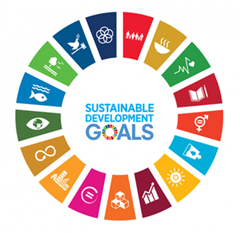Journal Highlight: Reproductive Health and SDG3
Published in Healthcare & Nursing, Sustainability, and Public Health

 Reproductive Health, an international, open-access journal published by BioMed Central, focuses on advancing the understanding of family planning, maternal health, and sexual health, in alignment with Sustainable Development Goal 3 (SDG3) targets 3.1 and 3.7.
Reproductive Health, an international, open-access journal published by BioMed Central, focuses on advancing the understanding of family planning, maternal health, and sexual health, in alignment with Sustainable Development Goal 3 (SDG3) targets 3.1 and 3.7..jpg)
.jpg)
.jpg)
Reducing maternal mortality (3.1) and ensuring universal access to sexual and reproductive health (SRH) care services (3.7) are key targets set by the United Nations, with the aim of reducing the global maternal mortality ratio to less than 70 per 100,000 live births and increasing the proportion of women of reproductive age (aged 15-49 years) who have their need for family planning satisfied with modern methods.
Progress in these areas has been mixed. Whilst the global maternal mortality ratio marginally declined from 227 maternal deaths per 100,000 live births in 2015 to 223 in 2020, regions such as sub-Saharan Africa and Southern Asia continue to see high maternal death rates. Similarly, whilst we have seen an increase of more than 75 million women using modern methods of family planning since 2015, some 270 million women lack access to modern contraceptive methods, particularly those in low- and middle-income countries (LMICs). To meet these SDG3 targets by 2030, substantial investment is needed to address these challenges, with a particular focus on vulnerable groups and regions.
Reproductive Health provides a platform to address critical issues affecting SRH across diverse populations, with an emphasis on LMICs. Recognising the need for evidence-based approaches to improve health outcomes, the journal publishes an array of study designs from scoping reviews, to qualitative research, to implementation science, with a focus on globally relevant research. In a recent study, Logie et al. conducted a comprehensive review of literature published from 1998 to 2023, analysing 92 studies across 100 countries to assess the SRH needs of forcibly displaced persons living in urban LMICs. They focused on various dimensions of SRH, including comprehensive sexuality education and safe abortion care. The review highlights that significant barriers exist that hinder access to essential SRH services, necessitating innovative approaches to address these challenges and achieve target 3.7.
To further this, the journal publishes implementation science as researchers aim to integrate evidence-based practices into routine use in health care and public health settings. The Adequate Childbirth Program aims to address the high rates of unnecessary cesaerean sections in Brazilian private hospitals. Following its implementation, significant changes were observed in labour and childbirth care practices, including the adoption of skin-to-skin contact and improved prenatal education. In an analysis by de Oliveira et al., the impact of the program was evaluated and revealed positive shifts towards more supportive practices for women. The implications of this study are significant for improving maternal care and addressing target 3.1 in reducing maternal mortality and increasing the proportion of births attended by skilled health personnel.
 Reproductive Health has experienced significant growth, establishing itself as a leading platform for research and discourse on reproductive health, rights, and technologies worldwide. "Through its commitment to rigorous scientific inquiry and inclusive, evidence-based practices, the journal plays a vital role in advancing the understanding of reproductive health issues that affect millions," Editors-in-Chief Dr Sanni Yaya and Dr Bright Ahinkorah explain. "Supporting SDG3 is crucial, as it encompasses universal access to sexual and reproductive health services, maternal health improvements, and the prevention of diseases, aligning directly with the journal’s mission," the Editors-in-Chief confirm. "By promoting research that addresses inequalities and improves health outcomes, Reproductive Health contributes meaningfully toward achieving SDG3 and fostering a healthier, more equitable future."
Reproductive Health has experienced significant growth, establishing itself as a leading platform for research and discourse on reproductive health, rights, and technologies worldwide. "Through its commitment to rigorous scientific inquiry and inclusive, evidence-based practices, the journal plays a vital role in advancing the understanding of reproductive health issues that affect millions," Editors-in-Chief Dr Sanni Yaya and Dr Bright Ahinkorah explain. "Supporting SDG3 is crucial, as it encompasses universal access to sexual and reproductive health services, maternal health improvements, and the prevention of diseases, aligning directly with the journal’s mission," the Editors-in-Chief confirm. "By promoting research that addresses inequalities and improves health outcomes, Reproductive Health contributes meaningfully toward achieving SDG3 and fostering a healthier, more equitable future."
Reproductive Health is currently calling for research on enhancing gender equity in reproductive health service access to address target 3.7 and SDG5 and has recently launched a special issue on comprehensive sexuality education to address the needs of adolescents and young people.
Follow the Topic
-
Reproductive Health

This journal focuses on all aspects of human reproduction, including adolescent health, female fertility, contraception, and maternal health and all articles are open access.
What are SDG Topics?
An introduction to Sustainable Development Goals (SDGs) Topics and their role in highlighting sustainable development research.
Continue reading announcementRelated Collections
With Collections, you can get published faster and increase your visibility.
Exploring the Role of Menstruation in School Girls’ Sexual and Reproductive Health in Low-Resource Settings
This collection seeks to examine the multifaceted impact of menstruation—including menstrual health, hygiene, and justice—on adolescent girls’ sexual and reproductive health (SRH) within educational settings in low-resource contexts. These include low- and middle-income countries (LMICs), high-income countries (HICs) with marginalized populations, and communities facing socioeconomic disadvantages, homelessness, or geographic isolation (e.g., rural and remote areas).
We aim to spotlight how inadequate menstrual health in these contexts can hinder girls’ educational experiences and broader life outcomes. Poor menstrual health is not only a barrier to consistent school attendance and academic performance but also has far-reaching implications for sexual and reproductive health, gender equality, and long-term economic empowerment. We are particularly interested in studies that explore the intersectionality of menstrual health with other social determinants of health and education, and that evaluate the effectiveness of interventions, policies, and innovative approaches aimed at improving menstrual equity.
We welcome original research—both qualitative and quantitative—that investigates the challenges adolescent girls face with regards menstrual health while attending school, including those linked to reproductive and sexual health, and that proposes actionable solutions. Key areas of interest include, but are not limited to:
• Sociocultural taboos, stigma, and lack of a supportive school environment
• Educational gaps in menstrual and reproductive health literacy
• Causes of menstruation-related school absenteeism beyond a lack of products, and this absenteeism’s impact on academic and psychosocial outcomes
• Strategies to engage boys and male educators in fostering a positive and inclusive menstrual health culture
• Understanding the links between menstruation and other areas of sexual and reproductive health, including the links between menstruation and reproductive justice, and contraception and family planning
By bringing together diverse perspectives and evidence-based research, this collection aspires to inform policy, guide program development, and ultimately contribute to the empowerment and well-being of adolescent girls in under-resourced educational settings.
This Collection supports and amplifies research related to SDG 3, Good Health and Well-Being, SDG 4, Quality Education, SDG 6, Clean Water and Sanitation, and SDG 10: Reduced Inequality.
We are committed to supporting participation in this issue wherever resources are a barrier. For more information about what support may be available, please visit OA funding and support, or email OAfundingpolicy@springernature.com or contact the Editor-in-Chief.
Publishing Model: Open Access
Deadline: Feb 27, 2026
Reproductive Health Equity for Migrants, Refugees, and Internally Displaced Populations
This collection aims to assess disparities and barriers in access to maternal care, contraception, and safe delivery services among displaced populations —both within and across countries— compared to host communities in low- and middle-income countries (LMICs) and developed countries. Displaced populations often face significant challenges in accessing essential healthcare services, which can lead to poorer health outcomes for mothers and infants. These challenges include higher rates of maternal and infant mortality, due to inadequate access to quality maternal care and contraception, as well as increased rates of cervical and breast cancer, due to low rates of vaccination and inadequate screening.
The collection welcomes studies that explore various approaches to address these disparities, including:
• Improving cultural competency among healthcare providers. By understanding and respecting the cultural backgrounds of displaced populations, healthcare providers can offer more effective and personalized care.
• Increasing financial access to healthcare services. Many displaced individuals face financial barriers that prevent them from seeking necessary medical care. Strategies to reduce these financial obstacles can significantly improve health outcomes.
• Involving communities in the design and implementation of health programs. Community engagement ensures that health interventions are tailored to the specific needs and preferences of the populations they serve. This participatory approach can lead to more sustainable and impactful health programs.
• Encouraging innovative approaches and the implementation of relevant technologies among migrants and refugees.
• Raising awareness of prevention, screening, and access to care for cervical and breast cancers.
Overall, this collection aims to highlight innovative solutions and best practices to reduce health disparities and improve maternal and infant health among international and internally displaced populations.
This Collection supports and amplifies research related to SDG 1, No Poverty, SDG 3, Good Health and Well-Being, and SDG 10, Reduced Inequalities.
We are committed to supporting participation in this issue wherever resources are a barrier. For more information about what support may be available, please visit OA funding and support, or email OAfundingpolicy@springernature.com or contact the Editor-in-Chief.
Publishing Model: Open Access
Deadline: Mar 20, 2026





Please sign in or register for FREE
If you are a registered user on Research Communities by Springer Nature, please sign in